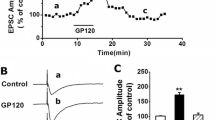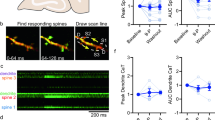Abstract
Human immunodeficiency virus type 1 (HIV-1)-infected mononuclear phagocytes (brain macrophages and microglial cells) release proinflammatory cytokines and chemokines. Elevated levels of chemokine CC motif ligand 2 (CCL2, known previously as monocyte chemoattractant protein-1) have been detected in serum and cerebrospinal fluid (CSF) of HIV-1-infected individuals and the raised CCL2 in the CSF correlates with HIV-1-associated neurocognitive disorders. To understand how elevated CCL2 induces HIV-1-associated neuropathy, we studied effects of CCL2 on excitatory postsynaptic current (EPSCs) in the CA1 region of rat hippocampal brain slices using whole-cell patch recording techniques. The AMPA receptor (AMPAR)-mediated EPSC (EPSCAMPAR) and N-Methyl-D-aspartate (NMDA) receptor (NMDAR)-mediated EPSCs (EPSCNMDAR) were isolated pharmacologically. Bath application of CCL2 produced a significant enhancement of the amplitudes of EPSCs, EPSCAMPAR and EPSCNMDAR. Further studies revealed that CCL2 potentiated NMDAR subtype NR2A-mediated EPSC (EPSCNR2AR) and NR2B-mediated EPSC (EPSCNR2BR). To determine the site of action, we recorded spontaneous mini EPSCs (mEPSC) before and during bath application of CCL2. Our results showed that CCL2 decreased inter event interval (IEI) and increased the frequency of mEPSCs without change on the amplitude, suggesting a presynaptic site of CCL2 action. CCL2 was also found to injure primary rat hippocampal neuronal cultures and neuronal dendrites in the CA1 region of hippocampal slices. The CCL2-associated neuronal and dendritic injuries were blocked by a specific NMDAR antagonist or by a CCR2 receptor antagonist, indicating that CCL2-associated neural injury was mediated via NMDARs and/or CCR2 receptors. Taken together, these results suggest a potential role CCL2 may play in HIV-1-associated neuropathology.





Similar content being viewed by others
References
Alfahad TB, Nath A (2013) Update on HIV-associated neurocognitive disorders. Curr Neurol Neurosci Rep 13:387
Antinori A et al. (2007) Updated research nosology for HIV-associated neurocognitive disorders. Neurology 69:1789–1799
Blair RE, Deshpande LS, Sombati S, Elphick MR, Martin BR, DeLorenzo RJ (2009) Prolonged exposure to WIN55,212-2 causes downregulation of the CB1 receptor and the development of tolerance to its anticonvulsant effects in the hippocampal neuronal culture model of acquired epilepsy. Neuropharmacology 57:208–218
Bonfoco E, Krainc D, Ankarcrona M, Nicotera P, Lipton SA (1995) Apoptosis and necrosis: two distinct events induced, respectively, by mild and intense insults with N-methyl-D-aspartate or nitric oxide/superoxide in cortical cell cultures. Proc Natl Acad Sci U S A 92:7162–7166
Chen Q, He S, Hu XL, Yu J, Zhou Y, Zheng J, Zhang S, Zhang C, Duan WH, Xiong ZQ (2007) Differential roles of NR2A- and NR2B-containing NMDA receptors in activity-dependent brain-derived neurotrophic factor gene regulation and limbic epileptogenesis. J Neurosci 27:542–552
Cinque P, Vago L, Mengozzi M, Torri V, Ceresa D, Vicenzi E, Transidico P, Vagani A, Sozzani S, Mantovani A, Lazzarin A, Poli G (1998) Elevated cerebrospinal fluid levels of monocyte chemotactic protein-1 correlate with HIV-1 encephalitis and local viral replication. AIDS 12:1327–1332
Conant K, Garzino-Demo A, Nath A, McArthur JC, Halliday W, Power C, Gallo RC, Major EO (1998) Induction of monocyte chemoattractant protein-1 in HIV-1 Tat-stimulated astrocytes and elevation in AIDS dementia. Proc Natl Acad Sci U S A 95:3117–3121
Deshmane SL, Kremlev S, Amini S, Sawaya BE (2009) Monocyte chemoattractant protein-1 (MCP-1): an overview. J Interf Cytokine Res 29:313–326
Dhillon NK, Williams R, Callen S, Zien C, Narayan O, Buch S (2008) Roles of MCP-1 in development of HIV-dementia. Front Biosci 13:3913–3918
Di Stefano G, Casoli T, Fattoretti P, Gracciotti N, Solazzi M, Bertoni-Freddari C (2001) Distribution of map2 in hippocampus and cerebellum of young and old rats by quantitative immunohistochemistry. J Histochem Cytochem 49:1065–1066
Fan X, Jin WY, Wang YT (2014) The NMDA receptor complex: a multifunctional machine at the glutamatergic synapse. Front Cell Neurosci 8:160
Feng B, Tse HW, Skifter DA, Morley R, Jane DE, Monaghan DT (2004) Structure-activity analysis of a novel NR2C/NR2D-preferring NMDA receptor antagonist: 1-(phenanthrene-2-carbonyl) piperazine-2, 3-dicarboxylic acid. Br J Pharmacol 141:508–516
Feng B, Morley RM, Jane DE, Monaghan DT (2005) The effect of competitive antagonist chain length on NMDA receptor subunit selectivity. Neuropharmacology 48:354–359
Fujikawa DG (2015) The role of excitotoxic programmed necrosis in acute brain injury. Comput Struct Biotechnol J 13:212–221
Galasso JM, Liu Y, Szaflarski J, Warren JS, Silverstein FS (2000) Monocyte chemoattractant protein-1 is a mediator of acute excitotoxic injury in neonatal rat brain. Neuroscience 101:737–744
Gao YJ, Zhang L, Samad OA, Suter MR, Yasuhiko K, Xu ZZ, Park JY, Lind AL, Ma Q, Ji RR (2009) JNK-induced MCP-1 production in spinal cord astrocytes contributes to central sensitization and neuropathic pain. J Neurosci 29:4096–4108
Grant I (2008) Neurocognitive disturbances in HIV. Int Rev Psychiatry 20:33–47
Heaton RK et al. (2011) HIV-associated neurocognitive disorders before and during the era of combination antiretroviral therapy: differences in rates, nature, and predictors. J Neuroviol 17:3–16
Hoskison MM, Shuttleworth CW (2006) Microtubule disruption, not calpain-dependent loss of MAP2, contributes to enduring NMDA-induced dendritic dysfunction in acute hippocampal slices. Exp Neurol 202:302–312
Hoskison MM, Yanagawa Y, Obata K, Shuttleworth CW (2007) Calcium-dependent NMDA-induced dendritic injury and MAP2 loss in acute hippocampal slices. Neuroscience 145:66–79
Huo TG, Li WK, Zhang YH, Yuan J, Gao LY, Yuan Y, Yang HL, Jiang H, Sun GF (2015) Excitotoxicity Induced by Realgar in the Rat Hippocampus: the Involvement of Learning Memory Injury, Dysfunction of Glutamate Metabolism and NMDA Receptors. Mol Neurobiol 51:980–994
Kelder W, McArthur JC, Nance-Sproson T, McClernon D, Griffin DE (1998) Beta-chemokines MCP-1 and RANTES are selectively increased in cerebrospinal fluid of patients with human immunodeficiency virus- associated dementia. Ann Neurol 44:831–835
Kim MJ, Dunah AW, Wang YT, Sheng M (2005) Differential roles of NR2A- and NR2B-containing NMDA receptors in Ras-ERK signaling and AMPA receptor trafficking. Neuron 46:745–760
Kim RY, Hoffman AS, Itoh N, Ao Y, Spence R, Sofroniew MV, Voskuhl RR (2014) Astrocyte CCL2 sustains immune cell infiltration in chronic experimental autoimmune encephalomyelitis. J Neuroimmunol 274:53–61
Marzocchetti A, Cingolani A, Giambenedetto SD, Ammassari A, Giancola ML, Cauda R, Antinori A, Luca AD (2005) Macrophage chemoattractant protein-1 levels in cerebrospinal fluid correlate with containment of JC virus and prognosis of acquired immunodeficiency syndrome–associated progressive multifocal leukoencephalopathy. J Neurovirol 11:219–224
Monyer H, Burnashev N, Laurie DJ, Sakmann B, Seeburg PH (1994) Developmental and regional expression in the rat brain and functional properties of four NMDA receptors. Neuron 12:529–540
Muratori C, Mangino G, Affabris E, Federico M (2010) Astrocytes contacting HIV-1-infected macrophages increase the release of CCL2 in response to the HIV-1-dependent enhancement of membrane-associated TNFalpha in macrophages. Glia 58:1893–1904
Nath A (2015) Eradication of human immunodeficiency virus from brain reservoirs. J Neurovirol 21:227–234
Ohno K, Okada M, Tsutsumi R, Sakamoto S, Yamaguchi T (1998) The AMPA-receptor antagonist YM90K reduces AMPA receptor-mediated excitotoxicity in rat hippocampal cultures. Jpn J Pharmacol 76:105–108
Parsons MP, Raymond LA (2014) Extrasynaptic NMDA receptor involvement in central nervous system disorders. Neuron 82:279–293
Prentice H, Modi JP, Wu JY (2015) Mechanisms of Neuronal Protection against Excitotoxicity, Endoplasmic Reticulum Stress, and Mitochondrial Dysfunction in Stroke and Neurodegenerative Diseases. Oxidative Med Cell Longev 2015:964518
Ragin AB, Wu Y, Storey P, Cohen BA, Edelman RR, Epstein LG (2006) Monocyte chemoattractant protein-1 correlates with subcortical brain injury in HIV infection. Neurology 66:1255–1257
Reaux-Le Goazigo A, Van Steenwinckel J, Rostene W, Melik Parsadaniantz S (2013) Current status of chemokines in the adult CNS. Prog Neurobiol 104:67–92
Sheehan JJ, Zhou C, Gravanis I, Rogove AD, Wu YP, Bogenhagen DF, Tsirka SE (2007) Proteolytic activation of monocyte chemoattractant protein-1 by plasmin underlies excitotoxic neurodegeneration in mice. J Neurosci 27:1738–1745
Shiramizu B, Lau E, Tamamoto A, Uniatowski J, Troelstrup D (2006) Feasibility assessment of cerebrospinal fluid from HIV-1-infected children for HIV proviral DNA and monocyte chemoattractant protein 1 alleles. J Investig Med 54:468–472
Studzinski AL, Barros DM, Marins LF (2015) Growth hormone (GH) increases cognition and expression of ionotropic glutamate receptors (AMPA and NMDA) in transgenic zebrafish (Danio rerio). Behav Brain Res 294:36–42
Thames AD, Briones MS, Magpantay LI, Martinez-Maza O, Singer EJ, Hinkin CH, Morgello S, Gelman BB, Moore DJ, Heizerling K, Levine AJ (2015) The role of chemokine C-C motif ligand 2 genotype and cerebrospinal fluid chemokine C-C motif ligand 2 in neurocognition among HIV-infected patients. AIDS 29:1483–1491
Tomita S, Byrd RK, Rouach N, Bellone C, Venegas A, O'Brien JL, Kim KS, Olsen O, Nicoll RA, Bredt DS (2007) AMPA receptors and stargazin-like transmembrane AMPA receptor-regulatory proteins mediate hippocampal kainate neurotoxicity. Proc Natl Acad Sci U S A 104:18784–18788
Wang WT, Pan GQ, Zhang ZY, Suo ZW, Yang X, Hu XD (2015) Ht31 peptide inhibited inflammatory pain by blocking NMDA receptor-mediated nociceptive transmission in spinal dorsal horn of mice. Neuropharmacology 89:290–297
Watkins CC, Treisman GJ (2015) Cognitive impairment in patients with AIDS - prevalence and severity. HIV AIDS (Auckl) 7:35–47
Williams K (1993) Ifenprodil discriminates subtypes of the N-methyl-D-aspartate receptor: selectivity and mechanisms at recombinant heteromeric receptors. Mol Pharmacol 44:851–859
Xiong H, Baskys A, Wojtowicz JM (1996) Brain-derived peptides inhibit synaptic transmission via presynaptic GABAB receptors in CA1 area of rat hippocampal slices. Brain Res 737:188–194
Yadav A, Saini V, Arora S (2010) MCP-1: chemoattractant with a role beyond immunity: a review. Clin Chim Acta 411:1570–1579
Yao Y, Tsirka SE (2014) Monocyte chemoattractant protein-1 and the blood-brain barrier. Cell Mol Life Sci 71:683–697
Yuan L, Qiao L, Wei F, Yin J, Liu L, Ji Y, Smith D, Li N, Chen D (2013) Cytokines in CSF correlate with HIV-associated neurocognitive disorders in the post-HAART era in China. J Neurovirol 19:144–149
Zhou Y, Tang H, Liu J, Dong J, Xiong H (2011) Chemokine CCL2 modulation of neuronal excitability and synaptic transmission in rat hippocampal slices. J Neurochem 116:406–414
Acknowledgments
This work was supported by NIH grant R01 NS063878, R01 NS077873 (HX), the National Natural Science Foundation of China 81360192 (YZ), Guangxi Natural Science Foundation 2012GXNSFCA053004 (YZ), Guangxi Education Department Foundation 201203YB041 (YZ).
Author information
Authors and Affiliations
Corresponding authors
Ethics declarations
All applicable international, national, and/or institutional guidelines for the care and use of animals were followed. All procedures performed in studies involving animals were in accordance with the ethical standards of University of Nebraska Medical Center, Omaha, NE, USA.
Competing interests
The authors declare that they have no competing interests.
Rights and permissions
About this article
Cite this article
Zhou, Y., Tang, H. & Xiong, H. Chemokine CCL2 enhances NMDA receptor-mediated excitatory postsynaptic current in rat hippocampal slices-a potential mechanism for HIV-1-associated neuropathy?. J Neuroimmune Pharmacol 11, 306–315 (2016). https://doi.org/10.1007/s11481-016-9660-2
Received:
Accepted:
Published:
Issue Date:
DOI: https://doi.org/10.1007/s11481-016-9660-2




